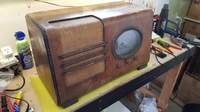5-valve broadcast band set
The BXU appears to be an updated but very similar circuit design to the model BBU from the previous year. The major difference seems to be that while the BBU had the earlier 6 and 7 pin valves, the BXU had been upgraded to the newer octal type. In terms of design, the control spacing seems wider than the previous year but other that that they are very similar. Even the cabinet design is similar to some versions of the previous years model (compare this to the Rolls model BBR for example).
 |
 |
| 1937 Rolls BBR | 1938 Ultimate BXU |
Intermediate Frequency: 256kc/s
Frequency Bands: 1
General Construction Notes for Radio (1936) Ltd:
Early Radio Ltd. schematics did not show the models, just the year, valves and bands, so some sleuthing is required to find the right one.
Early 30's Ultimate models with three digit model numbers indicated both the number of valves in the set, and the price it retailed for - for example, the model 856 was an 8-valve radio which retailed for $56 pounds. The equivalent Courier models were reversed, so an Ultimate 856 was a Courier 568 (theoretically, at least). This was the Auckland price though, and often the sets would retail for 1 or 2 pounds more in other centres, presumably to cover the freight cost of moving them around the country from the Auckland factory.
Note the use of old resistance terminology on older schematics: ω means ohms and Ω means megohms.
Some 1936-onward 3-letter chassis codes vary the last letter between brands, for example:
BBU - Ultimate model BB
BBR - Rolls (and Golden Knight) model BB
BBC - Courier model BB
All use the same chassis.
Golden Knight, Courier and Rolls appear to use the same copper-painted chassis while Ultimate chassis' are painted silver
After the war a new model code system was introduced, whereby radio models all began with R - the first model being the RA, a dual-wave 5-valve set commonly released in a pressed tin cabinet.